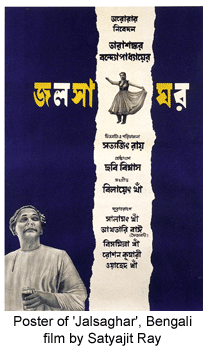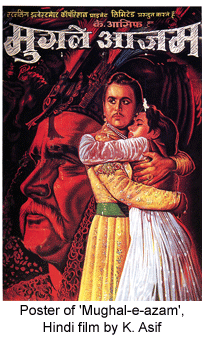- Ah, the heat
- Guest Editor’s Column
- Art Moderne: Art Deco Furniture
- Lithograph Tin Toys
- Film Memorabilia
- Creative Impulse
- Hard Talk
- Possibility of Democracy in China
- In the News
- Artist Index and Statistics
- Market Insight
- Auction Reports : What happened
- Auction Reports : what's forthcoming
- Art Bengaluru
- Art’s Eye-view
- The month that was
- Photo Feature
- Roerich bridges Indo-Russian Cultural Relations
- Image and Symbol: Painters' Perceptions
- Image and Symbol: Sculptors' Perceptions
- My Window Shut to Open
- Paramjit Singh
- Mrinalini Mukherjee
- The Spirit of A Butterfly
- Have I Ever Opposed You?
- S(outh) E(ast) A(sia)
- Splitting the Other
- The Things That Happen When Falling in Love
- Millijunction
- Terminology
- Know your Act
- Different hues of Aakriti
ART news & views
Film Memorabilia
Volume: 2 Issue No: 3 Month: 4 Year: 2010
 Today Film memorabilia and posters are accepted as fine popular cultures of India and sought after as enticing collectibles. Today in social sciences practices, popular cinema is a particularly potent political and cultural document thus crystallizing a new area of discipline. The audiovisual cuts across barriers of language, class, culture, region in highly diverse societies. Cultural theorists interrogate the cinema while being in dialogue with India as illusion supplier because India, in its own self- imaging, has given a prominent place to reflection as fantasy as the root of desire and agency which, in giving itself illusions and realities. These posters ultimately becoming the signifier of such sites in the public space. Cinema has always been a play of middle- class sensibilities and fantasy life and popular cinema (a genre which can publicly be ridiculed and secretly enjoyed at the same time) has become for this class both an ideological phalanx and a major vehicle self- expression and aspirations and often described as our 'secret politics of desire'. Vinay Lal and Ashis Nandy points out-' …..research of popular cinema often identified with post- modernist or post- structuralist schools of thought and theories of post-coloniality - the new discipline is also powered by the changing politics in South Asia. Politically, English speaking India has consistently lost ground in the culture of Indian politics during the last fifty years, though many observers in and outside India, have, in this respect, being misled by apparently contrary trends'.(Fingerprinting Popular Culture, OUP, 2006.)
Today Film memorabilia and posters are accepted as fine popular cultures of India and sought after as enticing collectibles. Today in social sciences practices, popular cinema is a particularly potent political and cultural document thus crystallizing a new area of discipline. The audiovisual cuts across barriers of language, class, culture, region in highly diverse societies. Cultural theorists interrogate the cinema while being in dialogue with India as illusion supplier because India, in its own self- imaging, has given a prominent place to reflection as fantasy as the root of desire and agency which, in giving itself illusions and realities. These posters ultimately becoming the signifier of such sites in the public space. Cinema has always been a play of middle- class sensibilities and fantasy life and popular cinema (a genre which can publicly be ridiculed and secretly enjoyed at the same time) has become for this class both an ideological phalanx and a major vehicle self- expression and aspirations and often described as our 'secret politics of desire'. Vinay Lal and Ashis Nandy points out-' …..research of popular cinema often identified with post- modernist or post- structuralist schools of thought and theories of post-coloniality - the new discipline is also powered by the changing politics in South Asia. Politically, English speaking India has consistently lost ground in the culture of Indian politics during the last fifty years, though many observers in and outside India, have, in this respect, being misled by apparently contrary trends'.(Fingerprinting Popular Culture, OUP, 2006.)
 The posters reflect where the key emphasis remains the myriad relations between globalization, local traditions and popular culture where social and political conflicts that are central concerns are virulent in its screenplay- bringing in an ambivalent language that facilitates the seizure of aesthetic, mythic and cultural meaning and thus becoming an important tool. The story telling act as sites of human characterizations of abstract concepts such as good and evil; the open ended, episodic and fragmented nature of the narrative minds conditioned by the notion of a linear meta- narrative of historical thinking, cemented together through devices such as family 'history', and 'filial love'; and the reemergence of 'Filmi'(read Hindustani) as secular film language (All families invent their parents and children; give each of them a story, character, fate, and even a language.”-Edward Said) It proves to be a seismograph of a society locked into a transformation process, establishing its own positions to confront a discourse of modernity determined by the west. The visual images of actors of Hindi cinema and others that helped in the construction of our cultural, social and national identities, these films made in Bombay (now Mumbai) are not mere portrayals of a popular genre but of our cultural icons that cut across regional and national boundaries resulting in a new class of popular cultic, eclectic and visual imagery of an invented nation. Posters of popular films that is crucially located in the terrain of culture that the nation, as an imagined community in these spaces, is most powerfully articulated into existence. The significance of Bombay's cinematic idiom, from this perspective, lies in the fact that it represents the hegemonic vocabulary of cultural terrain in Indian.
The posters reflect where the key emphasis remains the myriad relations between globalization, local traditions and popular culture where social and political conflicts that are central concerns are virulent in its screenplay- bringing in an ambivalent language that facilitates the seizure of aesthetic, mythic and cultural meaning and thus becoming an important tool. The story telling act as sites of human characterizations of abstract concepts such as good and evil; the open ended, episodic and fragmented nature of the narrative minds conditioned by the notion of a linear meta- narrative of historical thinking, cemented together through devices such as family 'history', and 'filial love'; and the reemergence of 'Filmi'(read Hindustani) as secular film language (All families invent their parents and children; give each of them a story, character, fate, and even a language.”-Edward Said) It proves to be a seismograph of a society locked into a transformation process, establishing its own positions to confront a discourse of modernity determined by the west. The visual images of actors of Hindi cinema and others that helped in the construction of our cultural, social and national identities, these films made in Bombay (now Mumbai) are not mere portrayals of a popular genre but of our cultural icons that cut across regional and national boundaries resulting in a new class of popular cultic, eclectic and visual imagery of an invented nation. Posters of popular films that is crucially located in the terrain of culture that the nation, as an imagined community in these spaces, is most powerfully articulated into existence. The significance of Bombay's cinematic idiom, from this perspective, lies in the fact that it represents the hegemonic vocabulary of cultural terrain in Indian.

If one crucially studies these film posters one would find the changing configuration of the “Indian woman” in popular cinema, with the laconic rural belle of the 50's like Kashmir ki kali now being replaced by her ethnic-chic, cosmopolitan, upper-class/caste counterpart; the New Indian 'Woman' in 'Race' or Karan Thapar saga defined above all by the agency displayed by 'falling' in love the pressures generated by the new identity of Indian woman and explored the history of desire in Bombay film, mapped onto transitions in India's state form that reconfigures the earlier opposition between “Indianness and “Westernization”. The identifying features of our cinemas portrayed by these posters have always been extensive use of music and dance, and the explicit stylization of roles and speech acts. Theorists like Nandy and Lal claim only a study of popular culture whose important tools are these memorabilia can link the ancient India of the philosophies to the modern India of the film industry.